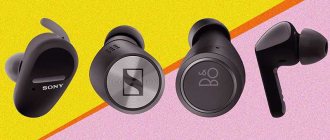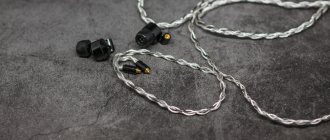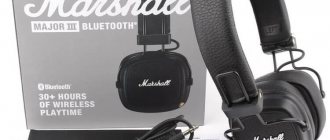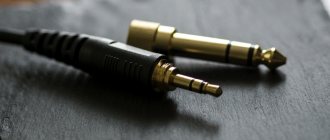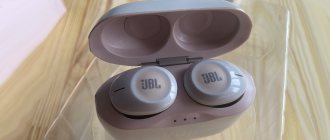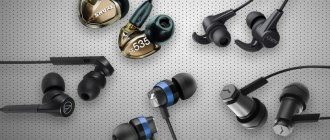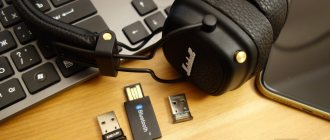Looking for portable, compact and lightweight headphones? Then you should give preference to earbuds or in-ear devices. But which option is needed? The article will help you figure out what is best to choose for specific cases.
The main features of vacuum and conventional headphones are described here, and their advantages are discussed. The disadvantages are also mentioned. All this will help you understand how these two options differ and which model is suitable for a particular user: simple or in-ear.
What are vacuum headphones
A vacuum (in-channel) headset is a device with a silicone nozzle. Their main advantage is comfort. All models in the TOP vacuum headphones https://audiotop.ru/ratings/luchshie-vnutrikanalnye-naushniki are selected precisely according to the criteria of convenience.
Despite the name, earplugs do not create low pressure inside the ear. The silicone tip helps seal the ear canal tightly, creating an enclosed space to ensure good noise isolation and complete immersion.
Decide why you need headphones
Headphones, like any gadget, are bought for specific tasks and purposes. You need to understand when and how you will use them. The choice of headphone type depends on the usage scenarios.
For home and office
For use at work and at home, full-size headsets are usually purchased, which provide full coverage of the auricle and the most comfortable fit on the head. This type is ideal for long-term listening to music.
You can also consider over-ear headphones, which, due to their smaller earcups, are usually more compact than full-size ones. They do not wrap around the auricle, but are placed on top. A striking example is Meizu HD50.
mymeizu.ru
The most popular among office headphones are closed acoustic models. They have better sound insulation, so your music will not be heard by others. The open type is suitable for home use. These headphones have holes on the outside of the ear cups that allow sound vibrations to travel in the same way as in a natural environment, making the sound more realistic.
When choosing over-ear or on-ear headphones, don't underestimate the importance of ear pad material. Velor or even synthetics make your ears not sweat as much as faux or natural leather.
For the city
For simple walks, it is quite possible to use the previously mentioned on-ear headphones. But if we are talking about traveling on the subway and traveling on other public transport, then the best choice would be in-ear headphones, also called earbuds. They are compact, extremely convenient to use and do not create problems when moving in a dense stream of people. Xiaomi Hybrid Pro HD can be called one of the best in terms of price and quality ratio.
mi.com
Headphones of this type are usually complemented by silicone ear pads of various sizes, so that each user can choose the right one. Also very popular are tips made of porous foam, which, heated by body heat, adapt to the human ear canal. Compared to silicone ones, they are less durable, but they hardly distort the sound.
The braid of the wire also plays an important role. One of the most practical is fabric, like, for example, the Bang & Olufsen Beoplay H5. This prevents the wire from tangling and reduces the risk of damage due to accidental pulling.
Separately, we can highlight completely wireless headphones like Apple AirPods. Accessories of this type provide maximum freedom of movement, but their price is quite high. In addition, there is a high risk of simply losing them.
For Sport
For running and the gym, in-ear wireless headsets are typically used. They may have neck-mounted arms or ear pads with hooks for better fixation inside the ear or on its outer part, as is the case with Xiaomi Mi Sports.
Many of these headsets are protected from sweat and even complete immersion under water, which allows you to swim without interrupting your favorite music.
jabra.ru
Recently, Bluetooth sports headphones have increasingly been equipped with sensors to track physical activity, as is the case with the Jabra Sport Pulse. Such headsets allow you to replace the usual fitness trackers, but they are also much more expensive than their classic counterparts.
For traveling
If you fly often and like to listen to music on the road, it makes sense to consider a headset with active noise cancellation. Most often these are large full-size headphones that can be either wired or wireless. Their ability to block out external sounds allows you to immerse yourself in your favorite music, even if a restless child is sitting next to you.
An important feature of travel headsets is their foldable design. It allows the headphones to take up much less space and reduces the risk of damage when transporting in a bag. Expensive models are often supplemented with a hard case for better protection.
For games
The choice of gamers is full-size, over-ear headphones with a built-in or detachable microphone. An important criterion when choosing is the presence of surround sound technology, like some Creative Sound BlasterX models. Simulating a 5.1 or even 7.1 configuration will be a big advantage in 3D action games, where you often have to navigate in space by ear.
creative.com
Most gaming headphones have a long, 2-meter wire. It is important that it has a reliable braid and rigid bulges at the plugs, eliminating kinks and possible breaks.
Noise reduction is also an important parameter. In this case, this applies to both headphones and a microphone, so that you are not distracted by external factors and can be heard well.
What are in-ear headphones
In-ear headsets (earbuds) are a kind of relic of the past, although the world's leading technology companies are doing their best to revive the traditional type of headphones. They have a shell-like shape; There is no silicone nozzle.
In some cases, they are loosely attached to the ear canal, which allows you to hear surrounding sounds. To ensure greater sealing and less irritation of the ear shells with plastic, they are supplied with foam tips; in-ear headphones are often included with inexpensive smartphones.
In-canal
In-ear headphones are very similar to in-ear headphones, and buyers often confuse them. In-ear headphones are also inserted into the ear, but have a deeper fit. Other definitions of these models have taken root among the people - “vacuum” or “plugs”.
In-ear headphones also have roots in the medical field - their progenitors are hearing correction devices, as well as stereo devices that have been used by musicians during performances for almost a quarter of a century - headphones-monitors.
What is the difference between in-ear headphones and in-ear headphones? In addition to a deeper position in the ear, they have a greater seal and increased sound concentration. The use of soft ear pads makes the sound in these headphones as isolated as possible from external noise sources, and the level of amplitude vibrations of the membrane is reduced by increasing the sound area.
In-ear headphones are provided with an impressive range of attachments. If you have a model in front of you that has unique spouts, then you can rest assured that you are dealing with in-ear headphones.
The disadvantage of in-ear headphones is the transmission of the high-frequency range, which is inferior to rich and sonorous bass.
Thus, in-ear headphones (“earbuds”) and in-ear headphones (“plugs”) are two completely different types of headphones that belong to models that are inserted directly into the ear.
Which headphones are better - vacuum or in-ear?
Let's compare two form factors of ear headsets, looking at them according to the main parameters:
- Dimensions.
- Sound quality and noise isolation.
- Hearing safety.
- Convenience.
- Price.
It is worth recalling that the choice of model is a purely individual matter; According to the presented criteria, two different people will in most cases choose two different types of headsets.
Size
Vacuum devices are considered more compact due to the diameter of the dynamic emitter membrane, the average value is from 10 to 12 mm. Models measuring 9 mm or smaller are less common. The diameter of the dynamic emitter membrane of the earbuds can be significantly larger - from 10 to 15 mm.
Sound quality and noise isolation
In-ear headphones, due to the lack of air circulation in the ear canal (due to the silicone tip), better drown out surrounding sounds, so the frequencies become more saturated and of higher quality. Deep penetration into the ear canal provides passive noise reduction.
This can be considered both a disadvantage and an advantage, depending on the purpose of the purchase. If the user needs to hear the surroundings, it is worth turning to earbuds. As a rule, their sound quality lags due to air circulation in the ear.
Hearing safety
Many users of in-ear headphones complain of headaches and discomfort in the ears after several hours of listening to music. This occurs due to the reduced pressure created in the ear canal. Due to the fact that the vacuum headset penetrates deep into the ear, carrying sound much closer to the eardrum than earbuds do, vibrations are created. There is a real risk of hearing damage when listening to music at high volumes.
Convenience
In this parameter, in-ear devices definitely win because they do not fall out; You can always choose a different size of silicone nozzle if it is not initially suitable.
Earbuds do not adapt to the shape and size of the ear, which is why many people experience discomfort while wearing them. Hard plastic can put a lot of pressure, causing swelling and the growth of bacteria, which leads to pimples in the ears.
Silicone tips need to be cleaned regularly as earwax gets into them throughout the day. The cleansing procedure usually takes 2 to 3 minutes of free time using a needle, toothpick or pin. Inserts are more susceptible to contamination of the mesh and small grooves, which undoubtedly takes longer to clean.
Price
The price of devices depends on the quality of the model and manufacturer. Most low-price devices are headphones with hard plastic without tips. Therefore, vacuum models are considered more expensive, but there are exceptions.
How to choose earbuds
When choosing modern acoustic systems, including headphones, you should focus on sound characteristics. Some manufacturers intentionally misindicate the performance of their devices. The same frequency range cannot be measured without special equipment, so any numbers can be written in the characteristics. However, it is impossible to choose headphones based on cost alone. Here are the parameters you need to pay attention to:
- Connection type. Depending on the connection method, headphones can be wired or wireless. The former transmit sound through a special cable, while the latter use an analog signal for this. The range of classic headphones is limited by the length of the wire, while Bluetooth devices operate at a distance of up to 10 meters. They have high functionality, but are more expensive.
- Mounting type. According to the type of fastening, earbuds come with an occipital arch, with ear “hooks” and clips. There are also headphones that stay in the ear due to special ear pads and pads.
- Impedance. This indicator is responsible for the resistance of the headphones. The higher the impedance, the more powerful the amplifier must be. High impedance devices are used in professional studios. Acceptable numbers for in-ear headphones are 16-32 Ohms.
- Sensitivity. The volume of the headphones depends on this characteristic. For comfortable listening, 90-110 dB is enough. The higher the sensitivity, the louder the headphones will play.
- Battery life. Wireless headphones require periodic charging from the mains. They are powered by a built-in battery. The larger the capacity, the longer the headphones will work in autonomous mode. It is better to choose headsets with a playback time of 10 hours or more.
The danger of vacuum headphones - myth or truth?
Proponents of healthy hearing complain about vacuum devices, arguing that they “damage hearing” by creating strong pressure in the ear. The statement that they can bleed is nothing more than a myth. The only danger lies in the volume level set by the user. Since the speaker of in-ear devices is located closer to the eardrum, you need to use such headphones more carefully.
Author: Vladislav Fevronin
Evaluate the basic characteristics
Regardless of the type and class, all headphones have basic technical characteristics that allow you to form an idea of the sound capabilities. When choosing relatively inexpensive headsets, you shouldn’t take such numbers too seriously, but you also shouldn’t ignore them.
Frequency range
This parameter characterizes the spectrum of sounds that the headphones can reproduce. The standard range is 20 - 20,000 Hz. The human ear simply does not recognize more, although in the description of headsets one can often find meanings that go beyond these limits. There is nothing bad about this, but it cannot be called an undeniable advantage either.
Sensitivity
Sensitivity tells how loud the headphones will play, all other things being equal. The relationship is direct: the higher the sensitivity, the higher the maximum volume. 95-100 dB or more is considered good for normal use.
Power
This parameter also affects the headphone volume ceiling, but it should only be taken into account by bass lovers using stationary amplifiers. In combination with a high-quality sound source, high-power headphones provide brighter and richer sound. If you are going to listen to music mainly from a smartphone, you are unlikely to be able to unlock the potential of high power.
Resistance
The nominal input resistance of headphones, also called impedance, affects both volume and overall sound quality. You need to focus on this parameter in accordance with the device with which you are going to use the headphones. For smartphones and portable equipment, you should select headsets with a lower impedance - up to 32 or even 16 Ohms, and for stationary devices - with a higher one, from 32 Ohms.
frequency response
The amplitude-frequency response is demonstrated in the form of a graph and characterizes the quality of transmission of various frequencies.
1 / 0
Frequency response of Beats Solo3. Raised bass, sagging midrange (Mid Range) and virtually no upper treble (High-Treble) / rtings.com
2 / 0
Frequency response Sony MDR-100AAP. A “hump” in the low frequency region indicates the bass range of the headphones, while at high frequencies there is clearly an imbalance with a strong dip in the upper frequencies / rtings.com
3 / 0
Frequency response of AKG K701. A clear lack of bass (left third of the graph), raised mid-treble frequencies (Mid-Treble) and failure in the upper treble / rtings.com
The minimum number of sharp bends in the frequency response curve indicates a balanced sound and accurate transmission of the original audio material. The height of the curve on the graph reflects the volume in a specific range. A “hump” at the beginning of the frequency response curve, at low frequencies, indicates that the headphones are bassy.
Plug
It should also be noted how to connect wired headphones. Most models on sale have a mini-jack plug (3.5 mm). A regular jack (6.3 mm) can be found on professional-level headsets, and a micro jack (2.5 mm) has become very rare lately. Nevertheless, pay attention to which plug the headset has and whether there is an adapter included.
Isodynamic
This type of headphone is based on a Hale emitter, a patent application for which was filed with the American Patent Office back in 1973. It was invented to produce louder and better sound from loudspeakers.
The advantages of isodynamic headphones are a significant power reserve and excellent playback quality. The radiating element in isodynamic headphones is a rectangular membrane, for which a thin Teflon film was used, coated with aluminum in the form of rectangular strips. The membrane is installed between magnets that form a powerful magnetic field. The current causes the plate to vibrate, and this is what the human ear perceives.
Invoices
These headphones have a fundamental difference from in-ear headphones - these accessories are fixed on the surface of the auricle, pressing against it from the outside, while the sound source is located outside the ear cavity.
Since on-ear headphones are located at some distance from the auricle, and from a sound standpoint - at a considerable distance, significant volume is required to ensure decent sound quality. We also note that over-ear headphones have another gradation within their type; they are divided according to the method of fastening - behind the ear (behind-the-ear) or through the top of the head (headband).
Reinforcement
Armature type headphones always have an in-ear design. The principle of operation is based on the use of a U-shaped magnetic circuit, which has a voice coil with an armature in its field. The cone is connected to an armature, and when current flows to the voice coil, the armature activates the movement of the cone.
The undoubted advantages of reinforcement headphones are their miniature appearance and high efficiency. Their sound is distinguished by its special purity and excellent clarity.
All of the above makes it possible to come to the following conclusion: in-ear headphone models can be dynamic; in-channel modifications - both dynamic and reinforcement; Over-ear headphones are mainly dynamic modifications; full-size models can be dynamic, electrostatic, as well as isodynamic and orthodynamic.
The next criterion by which modern headphones are divided is acoustic design. There are two categories of headphones, divided according to the way their housing is made - open and closed.
Electrostatic (or electret)
Such accessories belong to the Hi-End class. You are unlikely to be able to purchase these in most electronics retail stores - the reason is their high price, about two to three thousand dollars. As for the principle of operation of electrostatic headphones, it is as follows: between a pair of electrodes there is a thin membrane, the movement of which is activated by a high current, forming sound vibrations. Such modifications are completely protected from the slightest sound distortion. The only drawback (besides the price, of course) of electrostatic headphones is the need to use an amplifier with them, which is also quite large in size.
Monitor
At first glance, monitor headphones are not much different from full-size ones. In fact, this type of headphones can be fully classified as full-size, since they really completely cover the auricle. However, please note that monitor headphone models always have a more massive headband and always a thick, usually ring-shaped cord. These headphones have nothing to do with portable models.
Monitor headphones are an attribute exclusively for professionals, since they are distinguished by a wide frequency range, and the reproduction of sound compositions occurs without the “decorations” familiar to music lovers. As a result, the tunes you admire will definitely sound muffled and lacking in color in these professional headphones.
Monitor headphones Pioneer HDJ-2000
So, now you know that in terms of design, headphones are divided into in-ear, in-ear, full-size, on-ear and monitor.
Let's consider another group of headphones, where they differ in the type of emitter . There are five varieties here: dynamic, electrostatic, isodynamic, orthodynamic and reinforcement.
